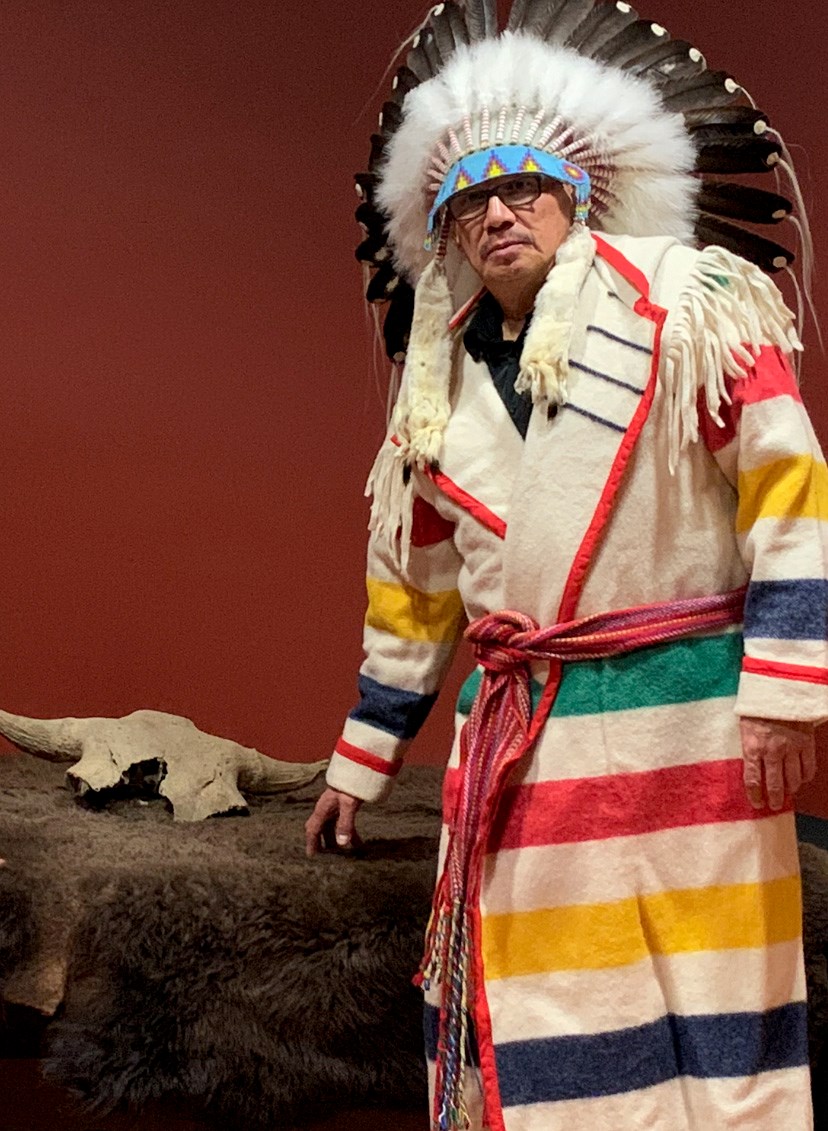BANFF – A welcoming ceremony with honour songs, smudging and prayer filled the air on Nov. 15, as the Siksika Nation accepted a 2,400 year-old bison skull found in Banff earlier this year.
“The Blackfoot people has a very close connection with the bison for years, since time immeorial,” said Sasheen Wright, museum technician and cultural curator at the Blackfoot Crossing Historical Park.
“The bison provided pretty much all of our needs, our shelter, our clothing, our tools and our nutrition – we hold the bison skull in very high regard and we are very pleased the Town of Banff [and Parks Canada] chose us to send it back to the Blackfoot people."
Unearthing the skull during a construction project on Lynx Street in February, Fortis Alberta began working with the Town and Parks Canada to carefully extract the skull while determining which Nation to repatriate the bone to.
“Parks Canada is committed to managing national parks, historic sites and marine conservation areas in a way that recognizes and honours the histories and cultures of Indigenous people, as well as the special relationships that Indigenous peoples have with traditional lands and waters,” Parks wrote in an official statement.
Recognizing that modern-day Banff National Park lies within the territories of Treaty 6, Treaty 7, Treaty 8, as well as the Métis Homeland, Parks Canada said it works with all of the Nations within the framework of its legal and policy obligations.
“Parks Canada recognizes the spiritual, cultural and historical significance of bison to Indigenous people, and provided the most recent bison skull that was discovered to the Siksika First National in response to their request,” Parks officials wrote.
“When items of cultural significance are requested, it has been Parks Canada’s practice for a number of years to provide them to Indigenous groups in the order that the cultural items are obtained and as circumstances allow.”
This is the second bison skull found in the last decade, with another skull found in 2011 and repatriated to the Stoney Nakoda First Nation.
With the most recent skull, Parks Canada archeologists used radiocarbon data to determine the skull's age to be at least 2,400 years old.
Some of the earliest bison finds, more than 10,000 years old, have been in the Lake Minnewanka area, approximately 14 kilometres north of the town site of Banff.
According to the Bison Blog by Parks Canada, bison mostly roamed the plains with the foothills and valleys of the mountains as part of its historical range.
“Some may have migrated in and out of the mountains, while others may have spent most, if not all, of their lives within the rugged valleys of the Rockies. A clue that tells us about where they spent their time is locked in the collagen of their bones,” the Bison Blog states.
Parks Canada also found a 2,000 year-old bison bone along the gravel bar in Banff National Park in April.
Meanwhile, the most recent bison skull found its permanent home in the Blackfoot Crossing Historical Park. Wright said the museum is hopeful to open an exhibit next year.
“Hopefully we will open an exhibit in the early spring showcasing the bison skull and Castle Mountain area … from what I gather this would be one of the first items we’ve acquired from the Town of Banff,” Wright said.
The newly acquired skull will also be one of the oldest artifacts for the national heritage site.
“Here at Blackfoot Crossing, we are dedicated to the promotion and preservation of the Blackfoot culture and the ceremony that was held, it is proof that these Blackfoot ways are still very much relevant and still very much alive to the Blackfoot people and this is something that [we] strive for – the preservation of Blackfoot culture,” she said.
While bison were absent from Banff National Park for nearly a century and a half, working with Indigenous nations across Alberta, two years ago, Parks Canada reintroduced a herd of 16 into the an enclosure in the Panther Valley. In 2018, Parks released the herd into its 1,200 square kilometre reintroduction area where it continues to thrive with a total 35 animals. Over the past two years, three bulls have dispersed from the herd and the national park. One was put down by Parks, while the other two were relocated back to Elk Island National Park.
A Buffalo Treaty was also signed in Montana in 2014 between eight nations including the Blackfoot, the Blood Tribe, Siksika Nation, Piikani Nation and Tsuu T’ina Nation. The treaty was brought to Banff in 2015 to be signed by the Stoney Nakoda and the Samson Cree.
The treaty's purpose includes to honour, recognize and revitalize the time immemorial relationship Nations have with the buffalo focusing on conservation, culture, economics, health, education and research.
Parks Canada officials said in the spirit of reconciliation and keeping with its commitment to renewed relationships with Indigenous people, its aim is to address future protocols for care, management and repatriation of cultural items from Banff National Park with interested Nations.
“Blackfoot Crossing Historical Park is honoured to be the people to take care of the bison skull permanently,” Wright said.




